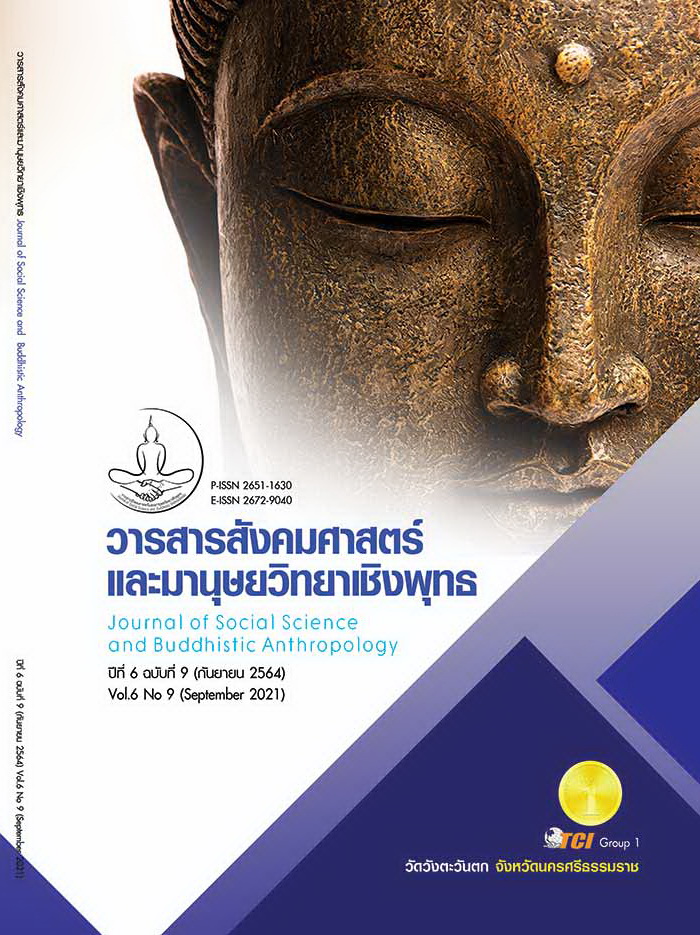INFLUENCE OF CAUSAL FACTORS ON CREATIVE WORK BEHAVIOR MANAGEMENT, EFFECTIVENESS OF INNOVATION AND ORGANIZATION PERFORMANCE OF FOOD PROCESSING BUSINESS IN THAILAND
Keywords:
Causal Factors, Creative Work Behavior Management, Effectiveness of Innovation, Organization Performance, Food Processing BusinessAbstract
The objectives of this article were to study Influence of causal factors on creative work behavior management, effectiveness of innovation and organization performance of food processing business in Thailand.The research used a quantitative research method. The tool used to collect data is a questionnaire. By collecting data with the sample, which is business owner or chief executive or human resources executive of food processing business in Thailand with 510 samples. The statistics used consisted of structural equation modeling. The research results were found that consistency index model confirmatory factor creative work behavior management of food processing business in Thailand the model was consistent with empirical data. With organizational performance as the end result of the model, it was found that the effectiveness of innovation It is the variable that has direct and total influence on the organizational performance the most. Followed by a variable for creative work behavior management. In addition, it was found that the creative work behavior management variable had a positive direct influence on the effectiveness of innovation variable and the organizational performance variable. It also had a positive indirect effect on the organizational performance variables. With the effectiveness of innovation variable acting as the mediator variable. Which this research complements the body of knowledge in past research and to create new knowledge, creative work behavior management. This will enable the food processing business to be effective for innovation and lead to good performance for the organization in the future.
References
กนกพร กระจ่างแสง. (2562). การจัดการนวัตกรรมเชิงสร้างสรรค์ของโรงพยาบาลเอกชนในประเทศไทย สู่ความเป็นเลิศด้านนวัตกรรมและผลการดำเนินงานขององค์การ. ใน วิทยานิพนธ์ปรัชญาดุษฎีบัณฑิต สาขาการจัดการ. มหาวิทยาลัยศิลปากร.
กรมพัฒนาธุรกิจการค้า กระทรวงอุตสาหกรรม. (2561). สถิติจำนวนธุรกิจอาหารที่จดทะเบียนการค้า. เรียกใช้เมื่อ 29 กันยายน 2562 จาก http://datawarehouse.dbd.go.th /bdw/menu/area.html
กรมวิชาการเกษตร กองพัฒนาระบบและรับรองมาตรฐานสินค้าพืช. (2559). รายงานวิชาการ เรื่องการพัฒนาอุตสาหกรรมแปรรรูปข้าวไทย. เรียกใช้เมื่อ 19 มกราคม 2562 จาก http://www.acfs.go.th/qmark/download/plant_pass_gmp.pdf
กรมส่งเสริมการค้าระหว่างประเทศ. (2562). แนวโน้มตลาดอาหารปี 2562 มุ่งเน้นความยั่งยืนความใส่ใจต่อสุขภาพและความสะดวกสบาย. กรุงเทพมหานคร: กรมส่งเสริมการค้าระหว่างประเทศ.
กิตติพันธ์ คงสวัสดิ์เกียรติ และคณะ. (2552). ระเบียบวิธีการวิจัยทางธุรกิจ. กรุงเทพมหานคร: เพียร์สัน เอ็ดดูเคชั่น อินโดไชน่า.
ชัยวันพัทณ์ วีระสัย และทิพย์รัตน์ เลาหวิเชียร. (2562). อิทธิพลของภาวะผู้นำต่อผลการดำเนินงานด้านบริการผ่านนวัตกรรมการจัดการ. วารสารบริหารธุรกิจเทคโนโลยีมหานคร, 16(1), 1-26.
ฐิติมา พูลเพชร และคณะ. (2560). ความสัมพันธ์เชิงสาเหตุและผลลัพธ์ของการสร้างวัฒนธรรมนวัตกรรมในองค์การหลักฐานเชิงประจักษ์ของโรงงานผลิตชิ้นส่วนอิเล็กทรอนิกส์ที่ได้รับสิทธิ BOI ในจังหวัดพระนครศรีอยุธยา. วารสารวิชาการมหาวิทยาลัยฟาร์อีสเทอร์น, 12(1), 39-155.
ทศพร บุญวัชราภัย. (2558). ความคิดสร้างสรรค์ขององค์การเพื่อสร้างนวัตกรรมบริการและผลการดำเนินงานของธุรกิจ: ปรากฏการณ์เชิงประจักษ์ของโรงแรมบูติกไทย. ใน วิทยานิพนธ์ปรัชญาดุษฎีบัณฑิต สาขาวิชาการจัดการ. มหาวิทยาลัยศิลปากร.
พีรวุฒิ ศิริศักดิ์. (2559). ความสัมพันธ์เชิงสาเหตุของภาวะผู้นำการเปลี่ยนแปลง ความคิดสร้างสรรค์ในองค์กร นวัตกรรมองค์กรที่มีต่อผลการดำเนินงานของค์กร: กรณีศึกษาวิสาหกิจขนาดกลางและขนาดย่อม(SMEs). วารสารวิทยบริการมหาวิทยาลัย
สงขลานครินทร์, 27(3), 11-23.
ระวีวรรณ ทรัพย์อินทร์. (2560). ความคิดสร้างสรรค์กับผลิตรายการโทรทัศน์ที่มีคุณภาพ. วารสารวิชาการ Verodian E-Journal ฉบับมนุษยศาสตร์ สังคมศาสตร์ และศิลปะ, 10(3), 1039-1049.
สมพร ปานยินดี. (2558). ความสัมพันธ์เชิงสาเหตุและผลลัพธ์ของความสามารถในการจัดการความหลากหลาย: หลักฐานเชิงประจักษ์ของธุรกิจอุตสาหกรรมอาหารในประเทศไทย. ใน วิทยานิพนธ์ปรัชญาดุษฎีบัณฑิต สาขาการจัดการ. มหาวิทยาลัยศิลปากร.
สุดใจ ผ่องแผ้ว และนุจรี ภาคาสัตย์. (2559). รูปแบบความสามารถทางการแข่งขันของผู้ประกอบการ OTOP ที่เป็น SMEs ในประเทศไทย. วารสารวิชาการ Veridian E-Journal ฉบับมนุษยศาสตร์ สังคมศาสตร์ และศิลปะ, 9(3), 1659-1675.
สุดารัตน์ พิมลรัตนกานต์. (2562). ความสามารถในการจัดการนวัตกรรมเพื่อผลการดำเนินงานขององค์กรที่ยั่งยืนของอุตสาหกรรมการเกษตรในประเทศไทย. ใน ดุษฎีนิพนธ์ปรัชญาดุษฎีบัณฑิต สาขาการจัดการ. มหาวิทยาลัยศิลปากร.
อภิลักษณ์ ธรรมวิมุตติ. (2562). ความสามารถการจัดการการเรียนรู้ของพนักงานด้านสิ่งแวดล้อมของอุตสาหกรรมอาหารแปรรูปในประเทศไทย. ใน วิทยานิพนธ์ปรัชญาดุษฎีบัณฑิต สาขาการจัดการ. มหาวิทยาลัยศิลปากร.
Aaker, D. A. et al. (2001). Marketing Research. New York: John Wiley and Sons.
Alchian, A. & Demsetz, H. (1972). Production, Information Costs, and Economic Organization. The American Economic Review, 62(5), 777-795.
Cerne, M. et al. (2017). The Role of Multilevel Synergistic Interplay among Team Mastery Climate, Knowledge Hiding, and Job Characteristics in Stimulating Innovative Work Behavior. Human Resources Management Journal, 27(2), 281-299.
De Jong, J. & Den Hartog, D. (2010). Measuring Innovative Work Behavior. Creativity and Innovation Management, 19(1), 23-36.
Dobrivojevic, G. (2013). Analysis of the Competitive Environment of Tourist Destinations Aiming at Attracting FDI by Applying Porter’s Five Forces Model. British Journal of Economics, Management and Trade, 3(4), 359-371.
Fiedler, F. E. (1967). A Theory of Leader Effectiveness. NY: McGraw-Hill.
Grabowski, R. (2015). Agriculture, Labor Intensive Growth, and Structural Change: East Asia, Southeast Asia, and Africa. Journal of South Asian Development, 1(1), 43-64.
Hair, J., et al. (2010). Multivariate Data Analysis. (7th ed.). Upper Saddle River, New Jersey: Pearson Education International.
Kemp, R. G. M. et al. (2003). Innovation and Firm Performance. (SCALES-paper N200213). In EIM Business and Policy Research. Zoetermeer.
Khorshidi, S. et al. (2013). Identify Factors Affecting Organizational Creativity: A Literature Review. International Research Journal of Applied and Basic Sciences, 4(5), 1214-1220.
Liu, W. (2018). High-involvement Human Resource Practices, Employee Learning and Employability. Career Development International, 23(3), 312-326.
Lonial, S. C. & Carter, R. E. (2015). The Impact of Organizational Orientations on Medium and Small Firm Performance: A Resource-Based Perspective. Journal of Small Business Management, 53(1), 94-113.
Ministry of Commerce, Department of International Trade Promotion. (2016). Infographic: Thailand 4.0 Transforming towards the Value-Based Economy. Retrieved February 27, 2019, from http://www.thaitradeusa.com/home /?p=21763
Protogerou, A. et al. (2011). Dynamic Capabilities and Their Indirect Impact on Firm Performance. Industrial and Corporate Change, 21(3), 615-647.








